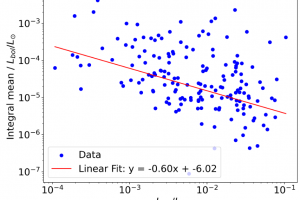Massa delle stelle ed intensità dei brillamenti. L’articolo: “Exploring short-term stellar activity in M dwarfs: A volume-limited perspective” di G. Galletta (UNIPA) pubblicato su A&A

Osservati e studiati 17229 brillamenti in 173 stelle di classe spettrale M entro 33 anni luce dalla Terra. Lo studio rivela che sono le stelle meno massicce a ospitare i brillamenti più energetici, mentre nelle stelle più massicce la variabilità è dominata da brillamenti meno intensi.
La produzione del campo magnetico nelle stelle avviene al loro interno, attraverso complessi processi fisici che dipendono principalmente dalla struttura interna, dal trasporto convettivo di energia e dalla rotazione stellare. Si tratta, ovviamente, di regioni che non possiamo osservare direttamente (fatta eccezione per le poche stelle la cui struttura interna può essere studiata tramite l’asterosismologia).
Come possiamo quindi studiare il campo magnetico delle stelle e collegarlo alle loro proprietà interne?
Una soluzione consiste nell’osservare i fenomeni transienti che si verificano nell’atmosfera stellare e che sono il risultato dell’interazione tra i campi magnetici locali e il plasma presente nella fotosfera, nella cromosfera e nella corona. In particolare, i brillamenti sono eventi rapidi che comportano un rilascio improvviso di energia sotto forma di radiazione, praticamente in tutte le bande dello spettro elettromagnetico.
Essi presentano un’ampia varietà in termini di durata e intensità, sia come picco di energia emessa sia come energia totale emessa durante l’intero evento. Studiare la statistica dei brillamenti e il loro legame con le proprietà stellari fornisce informazioni preziose sulla struttura interna delle stelle e su come questa influenzano i processi responsabili della generazione del campo magnetico.
Inoltre, l’intensa radiazione emessa durante i brillamenti più energetici può avere importanti conseguenze sulle atmosfere dei pianeti che orbitano vicino alla stella.
Il team di ricercatori guidato dall’astrofisico G. Galletta (Università degli Studi di Palermo e Blue Skies Space Italia S.R.L.) ha analizzato i dati del satellite NASA TESS relativi a 173 stelle di classe spettrale M entro 33 anni luce dalla Terra. TESS è un satellite progettato per la ricerca di esopianeti e produce curve di luce (ossia misure continue della luminosità stellare su lunghi intervalli temporali) di stelle in quasi tutto il cielo. Questo lo rende uno strumento prezioso per studiare i fenomeni responsabili della variabilità stellare.
Il team si è concentrato sulle stelle di classe spettrale M sia perché esse sono caratterizzate da un’intensa attività magnetica e perchè la loro fascia di abitabilità (ovvero la zona in cui pianeti rocciosi possono ospitare acqua liquida in superficie) è molto vicina alla stella, aumentando l’impatto dei brillamenti più forti sui pianeti potenzialmente abitabili.
In totale, il team ha analizzato 17229 brillamenti, scoprendo che quelli più energetici si verificano tipicamente nelle stelle M di massa più piccola. Al contrario, nelle stelle M più massicce, la variabilità su breve termine è dominata da brillamenti meno energetici.
Lo studio è descritto nell’articolo: “Exploring short-term stellar activity in M dwarfs: A volume-limited perspective“, recentemente pubblicato su Astronomy & Astrophysics in collaborazione con gli astronomi S. Colombo, L. Prisinzano e G. Micela del nostro Osservatorio.
La figura di copertina (cliccare qui per visualizzarla interamente) mostra la distribuzione dell’energia dei brillamenti analizzati, in funzione della luminosità bolometrica delle stelle, che varia da 0.0001 a 0.1 volte la luminosità del Sole.
Mario Giuseppe Guarcello
Segui MarioSpiegaCose su Instagram () , Facebook (), Youtube () e X ()
Segui la pagina Facebook e Instagram dell’Osservatorio Astronomico di Palermo
Iscriviti al canale Youtube dell’Osservatorio Astronomico di Palermo
